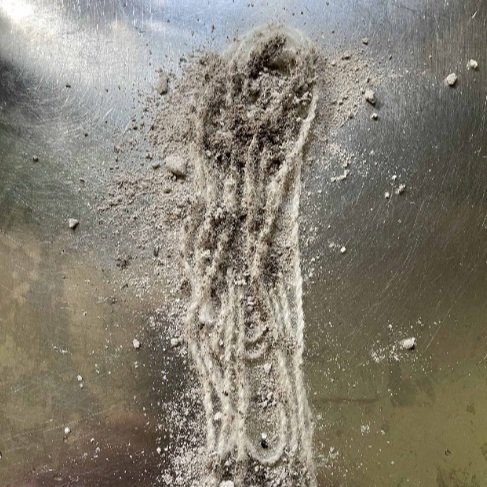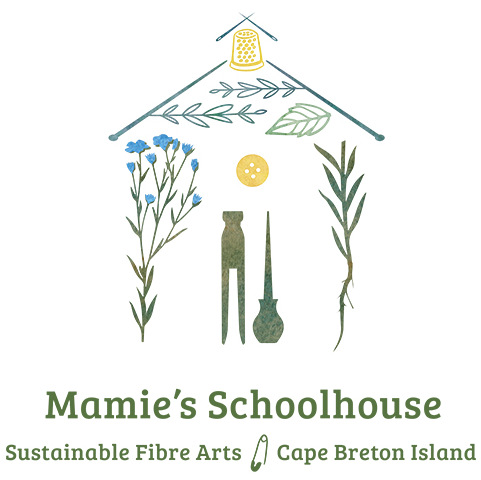Isabella Whitworth
devon, ENGLAND
The Income of Each Precious Thing. It is an image of the samples I dyed for the project, title courtesy of Shakespeare, commenting on the price of every endeavour.
Orchil is a historical purple dye made from a wide variety of lichens whose use stretches back into pre-history. It was a staple dye for European dyers until the mid-nineteenth century. It is very light-fugitive and will fade to beige in about three weeks when exposed in strong light. However, the unique beauty and freshness of its colour was greatly valued by dyers and analysis has confirmed its use in many costly textiles such as tapestries, and artefacts such as parchments. The dye is not available directly from the raw dyestuff and lichen must go through a lengthy and often unpredictable fermentation, sometimes of several weeks, to allow the dye precursors to develop into the characteristic purple. The colour reacts to pH, with acids producing a redder colour and alkali turning the colour towards blue.
Sourcing dye lichen and ecology: I am a practising textile artist, dyer, historical researcher, tutor and author. For the last 16 years I have been studying and publishing on the nineteenth century orchil trade. In connection with this research I have prepared and used very small batches of orchil to assist conservationists and chemists researching historical methods. However, I never use any type of lichen in my natural-dyed studio work.
Since 2008 I have prepared many successful batches of orchil, but always using extremely small amounts of dyestuff. It is now my policy never to collect lichen material from the wild (and that includes windfalls). The environmental pressures on our UK countryside are such that I believe no-one should be using orchil lichens for dyeing when there are alternative ways to produce a natural and lightfast purple. When I have assisted scientists and historians, and for studies such as the Stockholm and Leyden project, I have been able to draw on collections of lichen material donated to me by natural dyers who used to forage in the past, but now share my environmental concerns.
Making orchil the Stockholm way: In none of the four Stockholm methods I tried (or indeed, any of the others in the Papyri) is a method for the actual making of orchil given. It is assumed the reader has orchil ready-made. Some Stockholm instructions are very puzzling, as in, ‘Boil in drinking water three times as much archil as the weight of the wool, take the archil out..’. This 1) implies dyestuff is weighed at time of use, which is curious for a liquid, and 2) that it can be removed from a dye vessel, which orchil cannot. (Stockholm 108). For the four selected recipes I used orchil I had made months before the project commenced.
Stockholm 108: Dyeing with Archil
To dye with archil. Wash the wool as is previously described. For a mina of wool take 4 chus of urine and a half a mina of alum. Mix these, and at the same time make a fire beneath them until they boil up. Put the wool in and stir incessantly, but when the wool sinks down and the liquor subsides then rinse the wool out. Boil in drinking water three times as much archil as the weight of the wool, take the archil out, put the wool in and stir up uniformly until the wool becomes soaked. Then pulverize a quarter of a mina of chalcanthum for each mina of wool and mix them. Stir up incessantly and thereby make the wool uniform. Then take it out, rinse out and let the wool dry as in other cases.
INTRODUCTION:
I interpreted the instructions ‘as previously described’ to mean the ones used in 107, but I had to omit the potter’s clay for reasons of time. I used instructions in 109 to clean wool with wood ash. Quantities were guesswork so I used half the quantity of alum to wool and then covered the wool with a separate source of urine, making up two dye vessels. One sample was at pH7 and the other at pH9. Both preparations were boiled and rinsed. The quantity of orchil stated was puzzling as it compares a weight to a liquid so I added 40mls of orchil to each vessel.


Stockholm 109: Dyeing in Phoenician Color with Archil
Roll up the wool and sift ashes over it. Separate the rolls in a convenient manner and again shift ashes over them until the wool becomes clean and branny. Shake it out on the following day and rinse it out. After the washing, boil it with 6 chus of salt water for each mina of wool, mix in half a mina of alum and mordant the wool therein in the way mentioned. Rinse it out. Then cook, in rainwater, until it boils, three times as much archil as the weight of the wool. Pour in goat’s milk and stir up. Put the wool in and stir again until the color is thoroughly soaked in. Then take the wool out, rinse it and dry it, but in doing so protect it from smoke.
INTRODUCTION:
Wood ash and sea salt were used in enough water to cover the wool. Half weight to wool of potassium aluminium sulphate was used. A separate wool thread was to be a control sample and was cleaned by standard scouring, unmordanted, and dyed in orchil (vessel A). I worked with two vessels, cold-dyeing in tandem. The amount of goat’s milk was guesswork and about half the quantity of milk to orchil was added to vessel B. The liquid turned a milky purple pink. After an hour threads were removed and compared, samples kept and threads returned to their vessels. There was an appreciable difference in colour after one month.
Milk version appeared no more lightfast than standard..






Stockholm 110: Dyeing in Bright Red Purple
To dye in genuine bright red purple grind archil and take 5 cyathi of the juice for a mina of wool. If you wish a bright tint mix in ground natron (and) if you desire a still brighter one, chalcanthum.
INTRODUCTION:
Making natron: I used the recipe posted on the collaboration Facebook Group by Kerry Sowells.
Natron Recipe
1 cup sodium bicarbonate/ baking soda
1 cup sodium chloride/sea salt
1/2 cup sodium sulphate
1/2 cup sodium carbonate
Place in a pot, covering the compound with water just covering the very top, mix continually, and heat up to about medium heat. Let boil then keep mixing for a few minutes till it is melted together. Once mixed pour out on to a cookie sheet and either let it dry naturally or heat it up the oven to 300. It depends on the amount you make how long , but do not let it burn. About 30 mins for every 2 cups of natron or so. You want it to dry out and then you want to break it up so it is flaky a bit like Kosher salt.
Making chalcanthum: I used copper water made from a small length of copper plumbing pipe immersed in water and vinegar. I used three previously-dyed samples from my research collection, two of orchil-dyed silk and one of wool. I wetted them out and used the natron and chalcanthum as separate modifying baths. A small amount of heat was used. Silks and wool were ’modified’ at the same time.


Stockholm 111: The Book of Africanus: Preparation of Bright Red Purple
Take and put the mordanted wool into 1 choenix of krimnos and 4 choenices of archil. Boil these materials, put the wool in and leave it there unit later. Take it out and rinse it with salt water, then with fresh water.
INTRODUCTION:
I used two dyed samples from my research collection, one of orchil-dyed silk noil and one of wool.
I could find no definitive answer as to what krymnos was so I used American cochineal, which would not have been available to Egyptian dyers of the time, although other scale insect dyes probably were.
I removed the samples from the dye several times to check that I had achieved an effective overdye.
Samples were then rinsed as described, labelled and dried.


